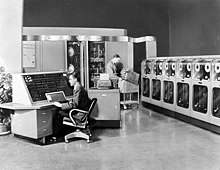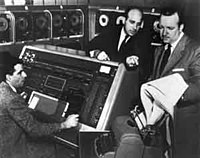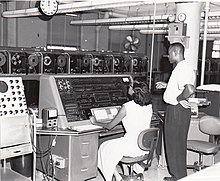UNIVAC I



The UNIVAC I (Universal Automatic Computer I) was the first general-purpose electronic digital computer design for business application produced in the United States. It was designed principally by J. Presper Eckert and John Mauchly, the inventors of the ENIAC. Design work was started by their company, Eckert–Mauchly Computer Corporation (EMCC), and was completed after the company had been acquired by Remington Rand (which later became part of Sperry, now Unisys). In the years before successor models of the UNIVAC I appeared, the machine was simply known as "the UNIVAC".[1]
The first Univac was accepted by the
History
Market positioning


The UNIVAC I was the first American computer designed at the outset for business and administrative use with fast execution of relatively simple arithmetic and data transport operations, as opposed to the complex numerical calculations required of scientific computers. As such, the UNIVAC competed directly against punch-card machines, though the UNIVAC originally could neither read nor punch cards. That shortcoming hindered sales to companies concerned about the high cost of manually converting large quantities of existing data stored on cards. This was corrected by adding offline card processing equipment, the UNIVAC Tape to Card converter, to transfer data between cards and UNIVAC magnetic tapes.[5] However, the early market share of the UNIVAC I was lower than the Remington Rand Company wished.[citation needed]
To promote sales, the company joined with CBS to have UNIVAC I predict the result of the 1952 Presidential election. After it predicted Eisenhower would have a landslide victory over
As the election continued it became clear that it had been correct all along: UNIVAC predicted Eisenhower would receive 32,915,949 votes and win the Electoral College 438–93[6] vis-à-vis final result Eisenhower receiving 34,075,029 popular votes in a 442–89 electoral College votes. UNIVAC had a margin of error of 3.5% of Eisenhower's popular vote tally, and four votes of his electoral vote total.[citation needed]
After the announcers admitted their sleight of hand, and their reluctance to believe the prediction, the machine became famous. This gave rise to a greater public awareness of computing technology,[7] while computerized predictions were a must-have part of election night broadcasts.[citation needed]
Installations

The first contracts were with government agencies such as the
The first sale, to the Census Bureau, was marked with a formal ceremony on March 31, 1951, at the Eckert–Mauchly Division's factory at 3747 Ridge Avenue, Philadelphia. The machine was not actually shipped until the following December, because, as the sole fully set-up model, it was needed for demonstration purposes, and the company was apprehensive about the difficulties of dismantling, transporting, and reassembling the delicate machine.[8] As a result, the first installation was with the second computer, delivered to the Pentagon in June 1952.[citation needed]
UNIVAC installations, 1951–1954
| Date | Customer | Comments |
|---|---|---|
| 1951 | U.S. Census Bureau , Suitland, MD
|
Not shipped until 1952[9][10] |
| 1952 | U.S. Air Force
|
Pentagon, Arlington, VA[11] |
| 1952 | U.S. Army Map Service | Washington, DC.[12] Operated at factory April–September 1952 |
| 1953 | New York University (for the Atomic Energy Commission) | New York, NY[13] |
| 1953 | Atomic Energy Commission | Livermore, CA |
| 1953 | U.S. Navy
|
David W. Taylor Model Basin, Bethesda, MD[13] |
| 1954 | Remington Rand | Sales office, New York, NY |
| 1954 | General Electric | Appliance Division, Louisville, KY. First business sale.[14] |
| 1954 | Metropolitan Life
|
New York, NY[15] |
| 1954 | U.S. Air Force
|
Wright-Patterson AFB , Dayton, OH
|
| 1954 | U.S. Steel | Pittsburgh, PA |
| 1954 | Du Pont
|
Wilmington, DE |
| 1954 | U.S. Steel | Gary, IN |
| 1954 | Franklin Life Insurance | Springfield, IL[16] |
| 1954 | Westinghouse
|
Pittsburgh, PA |
| 1954 | Pacific Mutual Life Insurance | Los Angeles, CA |
| 1954 | Sylvania Electric | New York, NY |
| 1954 | Consolidated Edison | New York, NY[17] |
Originally priced at US$159,000, the UNIVAC I rose in price until they were between $1,250,000 and $1,500,000. A total of 46 systems were eventually built and delivered.[citation needed]
The UNIVAC I was too expensive for most universities, and Sperry Rand, unlike companies such as
A few UNIVAC I systems stayed in service long after they were made obsolete by advancing technology. The Census Bureau used its two systems until 1963, amounting to 12 and 9 years of service, respectively. Sperry Rand itself used two systems in Buffalo, New York until 1968. The insurance company Life and Casualty of Tennessee used its system until 1970, totaling over 13 years of service.[citation needed]
Technical description
This section needs additional citations for verification. (March 2015) |
Major physical features

UNIVAC I used 6,103
Main memory details

The main memory consisted of 1000
Each 10-word mercury delay-line channel is made up of three sections:
- A channel in a column of mercury, with receiving and transmitting quartz piezo-electric crystals mounted at opposite ends.
- An intermediate frequency chassis, connected to the receiving crystal, containing amplifiers, detector, and compensating delay, mounted on the shell of the mercury tank.
- A recirculation chassis, containing cathode follower, pulse former and retimer, modulator, which drives the transmitting crystal, and input, clear, and memory-switch gates, mounted in the sections adjacent to the mercury tanks.[citation needed]

Instructions and data

Digits were represented internally using
Input/output
Besides the operator's console, the only I/O devices connected to the UNIVAC I were up to 10
Operations
A typical UNIVAC I installation had several ancillary devices. There were:
- The UNIPRINTER read metal UNIVAC magnetic tape using a tape reader and typed the data at 10 characters per second using a modified Remington typewriter.
- The UNIVAC Card to Tape converter read punched cards at 240 cards per minute and wrote their data on metal UNIVAC magnetic tape using a UNISERVO tape drive.
- A tape-to-card converter, that read a magnetic tape and produced punched cards.
UNIVAC did not provide an operating system. Operators loaded on a UNISERVO a program tape which could be loaded automatically by processor logic. The appropriate source and output data tapes would be mounted and the program started. Results tapes then went to the offline printer or typically for data processing into short-term storage to be updated with the next set of data produced on the offline card to tape unit. The mercury delay-line memory tank temperature was very closely controlled as the speed of sound in mercury varies with temperature. In the event of a power failure, many hours could elapse before the temperature stabilized.[citation needed]
Reliability
Eckert and Mauchly were uncertain about the reliability of digital logic circuits—little was known about them at the time. The UNIVAC had been designed with parallel computation circuits and a statistical comparison of the results. In practice, however, only failing components, i.e., the vacuum tubes, yielded comparison faults, as the circuit designs as such proved very reliable. A regimen was established to ensure the reliability of the fragile vacuum tubes, the choke point of the entire operation. Prior to use large lots of the predominant tube type 25L6 were burned in and thoroughly tested. (Often half of any given production lot would be thrown away.) Technicians would then install a tested and burned-in tube in an easily diagnosed location such as the memory recirculate amplifiers. Then, when further proven aged and proven reliable, this "golden" tube was sent to stock to be pulled out for difficult-to-diagnose logic positions.
Furthermore, it took approximately 30 minutes to turn on the computer—all
See also
- BINAC
- Ferranti Mark 1
- Grace Hopper
- History of computing hardware
- LEO (computer)
- List of UNIVAC products
- List of vacuum-tube computers
Notes
- ^
- ^ Reference: CNN's feature on the 50th anniversary of the UNIVAC.
- ISBN 9780262140904.
- LCCN 79-90567.
- ^ Univac i. (2003). In Encyclopedia of computer science. Retrieved from http://literati.credoreference.com/content/entry/encyccs/univac_i/0
- ^ Murphy, Eugene F.; Berkeley, Edmund C. (1953-01-01). "AUTOMATIC COMPUTERS ON ELECTION NIGHT". The Computing Machinery Field 1953-01: Vol 2 Iss 1. Internet Archive. Berkeley Enterprises. pp. 27–28.
- ^ Brinkley, Alan. American History: A Survey. 12th Ed.
- Charles Babbage Institute, University of Minnesota. 171-page transcript of oral history with computer pioneers involved with the Univac computer, held on 17–18 May 1990, Washington DC. The meeting involved 25 engineers, programmers, marketing representatives, and salesmen who were involved with the UNIVAC, as well as representatives from users such as General Electric, Arthur Andersen, and the U.S. Census.
- ISSN 0025-5718.
- ISSN 0025-5718.
- ISSN 0025-5718.
- ISSN 0025-5718.
- ^ a b "1. UNIVAC". Digital Computer Newsletter. 5 (3). Digital_Computer_Newsletter_V05N03_Jul53.pdf: 2. July 1953.
{{cite journal}}: CS1 maint: others (link) - ^ "THE UNIVAC". Digital Computer Newsletter. 6 (1): 2. Apr 1954.[dead link]
- ^ "7. UNIVAC". Digital Computer Newsletter. 6 (3): 4–5. Jul 1954.[dead link]
- ^ "2. The UNIVAC". Digital Computer Newsletter. 6 (2): 2. Jan 1954.[dead link]
- ^ Ceruzzi, Paul E. A history of modern computing, MIT, 1998. The source notes that the list is compiled from a number of sources and does not include UNIVACs that were completed not delivered in the period 1951–54. In some cases the dates are approximate. Depending on the definition of "installed" the order may be slightly different.
- ^ The vacuum tubes used in the UNIVAC I were mostly of type 25L6 (3,947), but the machine also used tubes of type 6AK5 (412), 7AK7 (363), 6AU6 (57), 6BE6 (?), 6SN7 (264), 6X5 (?), 28D7 (274), 807 (27), 829B (47), 2050 (151), 5545 (?), 5651 (?), 5687 (14), 5915 (96), 6AL5 (199), 6AN5 (136), 6AH6 (?), 5V4 (?), 5R4 (?), 4D32 (?), 3C23 (64), and 8008 (?).
- ^ "Totals: Germanium Diode Sales; Supply of Engineering Graduates - Computer Components". Tele-tech & Electronic Industries. Vol. 13. Internet Archive. Chilton Co. 1954-03-01. p. 3.
{{cite book}}: CS1 maint: others (link) - ^ Weik, Martin H. (March 1961). "UNIVAC I". ed-thelen.org. A Third Survey of Domestic Electronic Digital Computing Systems.
External links
- UNIVAC Conference Oral history on 17–18 May 1990. Charles Babbage Institute, University of Minnesota, Minneapolis. 171-page transcript of oral history with computer pioneers, including Jean Bartik, involved with the Univac computer, held on 17–18 May 1990. The meeting involved 25 engineers, programmers, marketing representatives, and salesmen who were involved with the UNIVAC, as well as representatives from users such as General Electric, Arthur Andersen, and the U.S. Census.
- Margaret R. Fox Papers, 1935–1976, Charles Babbage Institute, University of Minnesota. collection contains reports, including the original report on the ENIAC, UNIVAC, and many early in-house National Bureau of Standards (NBS) activity reports; memoranda on and histories of SEAC, SWAC, and DYSEAC; programming instructions for the UNIVAC, LARC, and MIDAC; patent evaluations and disclosures relevant to computers; system descriptions; speeches and articles written by Margaret Fox's colleagues; and correspondence of Samuel Alexander, Margaret Fox, and Samuel Williams.
- UNIVAC I documentation – From computer documentation repository www.bitsavers.org
- UNIVAC 1: The First Mass-Produced Computer – Unisys History Newsletter, Volume 5, Number 1 at the Wayback Machine (archived April 22, 2017)
- The UNIVAC and the Legacy of the ENIAC – From the University of Pennsylvania Library (PENN UNIVERSITY/exhibitions)
- UNIVAC 1 Computer System – By Allan G. Reiter, formerly of the ERA division of Remington Rand
- UNIVAC I & II Simulator Archived 2013-10-11 at the Wayback Machine – By Peter Zilahy Ingerman; Shareware simulator of the UNIVAC I and II. Archived download
- Core memory slide show – This slide show contains a photo of a 1951 core memory module for a UNIVAC I
- Remington-Rand Presents UNIVAC – Promotional film from the collection of the Computer History Museum, Mountain View, California
- "Winky Blinky Lights « Off The Broiler". archive.is. Pictures and video in flash of UNIVAC main console; sales and marketing documents. 10 December 2012. Archived from the original on 10 December 2012.
{{cite web}}: CS1 maint: bot: original URL status unknown (link) CS1 maint: others (link) - "Want To Buy A Brain", May 1949, Popular Science early illustrated article on the UNIVAC for the general public
- YouTube Video: 1951 UNIVAC 1 Computer Basic System Components – Computer History Archives Project
